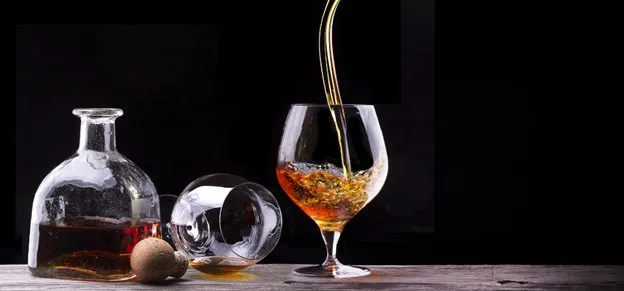We begin our voyage into the world of European brandy with the basics. Brandy, essentially, is a spirit distilled from wine or other fermented fruit juice. The name comes from the Dutch word ‘brandewijn,’ which means ‘burned wine.’ The ‘burning’ refers to the process of heating wine in the distillation process.
European brandy, known for its exquisite character and complex flavor profiles, stands out on the global stage. These spirits often carry the name of the region where they’re produced, their quality intrinsically tied to their geographical roots.
Cognac, Armagnac, and Calvados
These are the ‘big three’ of French brandies, each a unique expression of its region and traditions.
Cognac: Produced in the Charente and Charente-Maritime departments of France, Cognac is arguably the world’s most famous brandy. Double-distilled in copper pot stills, it must age for at least two years in French oak barrels. Cognac displays aromatic layers of fruit, floral notes, and a hint of spice. Cognacs like Hennessy XO, with tasting notes of candied fruit and dark chocolate, and Remy Martin XO, a symphony of jasmine, ripe figs, and juicy plums, are well worth a try.
Armagnac: Distilled once in column stills and aged in local black oak casks, Armagnac has a robust, full-bodied flavor. It hails from Gascony and is the oldest distilled spirit in France. A fine example is Chateau de Laubade XO, which boasts flavors of prune, vanilla, and warm spices.
Calvados: From Normandy, Calvados is apple (and sometimes pear) brandy, aged in oak casks for a minimum of two years. It offers flavors of crisp apple, fresh pear, and a hint of nuttiness. Calvados Drouin 12-year-old offers a rich palette of dried fruits and honey with a remarkable length on the palate.
There’s no denying that European brandies, particularly those from France, have had a substantial influence on the brandy industry worldwide. Historically, French brandies such as Cognac and Armagnac have set the bar high when it comes to quality and craftsmanship. From stringent geographic designations to strict production regulations, these standards have made European brandies the golden benchmark in the industry.
European brandies’ influence goes beyond mere production methods and regulations. They have also defined consumer expectations about what brandy should be. With their premium image, exquisite flavors, and age statements, they’ve shaped the public’s perception, setting a standard that other brandies strive to match.
Europe’s reverence for tradition has also inspired other regions. The Armagnac method of distillation, for example, is practiced in craft distilleries across the globe, with distillers acknowledging the role of this traditional technique in creating a more flavorful and characterful brandy.
Looking ahead, European brandies remain well-positioned to influence the industry’s future. With a growing global appetite for premium spirits and an increased interest in authentic, heritage-rich products, European brandies, with their centuries-old tradition and superior quality, are primed for continued success.
In contrast, the major competitor of European brandies, American brandy, traditionally viewed as a less expensive, less sophisticated spirit, is undergoing a renaissance. More American distillers are taking cues from their European counterparts, crafting brandies that are artisanal, terroir-driven, and often aged in oak barrels. Despite this, European brandies continue to dominate the premium segment, their reputation bolstered by their illustrious history and unwavering commitment to quality.
As for the future, it is likely that the influence of European brandy will continue to reverberate throughout the industry. Even as new regions and players emerge, the time-honored traditions, exacting standards, and unmatched quality of European brandy will ensure its esteemed status and global influence for years to come.
Tasting and Serving European Brandy: A Sensory Expedition
When it comes to tasting these distinguished spirits, the experience is as important as the drink itself. You’ll need a tulip glass or a snifter, the shape of which allows the brandy’s aromas to concentrate and rise to the nose.
To start your tasting session, pour a small amount into the glass and give it a gentle swirl. This movement aerates the brandy, helping to release its aroma. Put your nose near the rim of the glass and take a deep breath. Notice the different scents – can you pick up the fruits, spices, or maybe even floral notes?
Now, take a small sip. Let the brandy sit on your palate before swallowing, savoring the different flavors. Pay attention to its body and finish, the lingering taste that stays after you’ve swallowed. Is it long and warm? Or perhaps short and smooth?
Savory Companions: Food Pairings with Brandy
Pairing brandy with food enhances the overall tasting experience. Here are five culinary combinations that can highlight the complex flavor profiles of brandy:
- Foie Gras and Cognac: The velvety texture and rich flavors of foie gras pair wonderfully with a fruit-forward cognac like Courvoisier VSOP.
- Tarte Tatin and Calvados: The caramelized apples in a Tarte Tatin complement the fresh apple notes of a Calvados like Morin Hors d’Age.
- Roquefort Cheese and Armagnac: The saltiness and creaminess of Roquefort cheese bring out the sweeter, fruity notes in Armagnacs like Dartigalongue XO.
- Dark Chocolate and Cognac: Dark chocolate, with its bitter notes, balances the sweetness of cognacs like Martell VS Single Distillery.
- Roasted Almonds and Armagnac: The nutty flavors and crunchy texture of roasted almonds go hand-in-hand with a robust Armagnac like Janneau XO.
The world of European brandy is vast and diverse, and what better way to traverse it than by savoring each sip and learning along the way? And remember, every bottle tells a story – whether it’s a new find from your local liquor store or a gem from the online shelves of WhiskeyD. So raise your snifter, enjoy the moment, and revel in the exquisite artistry of European brandy.

